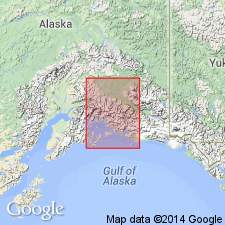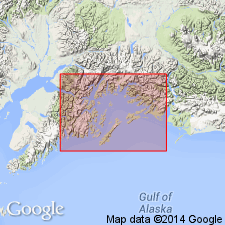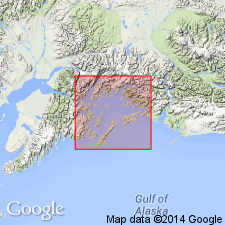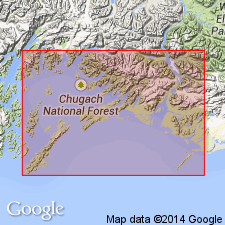
- Usage in publication:
-
- Orca series*
- Modifications:
-
- Named
- Dominant lithology:
-
- Arkose
- Sandstone
- Limestone
- Shale
- Slate
- AAPG geologic province:
-
- Alaska Southern region
Summary:
Forms north shore of Prince William Sound and its adjacent islands beginning below Orca and extends northward to Port Fidalgo and northwestward. Consists of thick bedded brown and gray sandstones, black limestones, arkoses, interbedded with usually thin layers of dark shale and slate and occasionally some conglomerate. Arkoses (which some geologists term graywacke) constitute larger portion of Orca rocks. Owing to upturned, folded and contorted attitude any statement of thickness would be hypothetical. Northward rocks become more highly metamorphosed and are called Valdes [Valdez] series (new). Fragmentary plant remains suggest possibility or slight probability that age is Late Cretaceous or early Tertiary.
Source: GNU records (USGS DDS-6; Menlo GNULEX).

- Usage in publication:
-
- Orca group*
- Modifications:
-
- Redescribed
- Dominant lithology:
-
- Graywacke
- Slate
- Greenstone
- AAPG geologic province:
-
- Alaska Southern region
Summary:
Orca series of Schrader (1900) redescribed as Orca group. Lithologically consists of graywackes, slates, greenstones with subordinate amounts of conglomerate and limestone.
Source: GNU records (USGS DDS-6; Menlo GNULEX).

- Usage in publication:
-
- Orca group*
- Modifications:
-
- Overview
- AAPG geologic province:
-
- Alaska Southern region
Summary:
Type locality designated as rocks of mainland adjacent to Orca Inlet and Orca Bay of southeastern Prince William Sound, southern AK. Historical overview, comparison with Valdez group, columnar section, distribution, lithology included in report. Age given as probably Late Cretaceous(?).
Source: GNU records (USGS DDS-6; Menlo GNULEX).

- Usage in publication:
-
- Orca Group*
- Modifications:
-
- Age modified
- Biostratigraphic dating
- Geochronologic dating
- AAPG geologic province:
-
- Alaska Southern region
Summary:
Age is late Paleocene through early middle Eocene based on combined paleontologic and radiometric data. Fossil localities and K-Ar sample localities shown on geologic sketch map. Age ranges shown in chart.
Source: GNU records (USGS DDS-6; Menlo GNULEX).
For more information, please contact Nancy Stamm, Geologic Names Committee Secretary.
Asterisk (*) indicates published by U.S. Geological Survey authors.
"No current usage" (†) implies that a name has been abandoned or has fallen into disuse. Former usage and, if known, replacement name given in parentheses ( ).
Slash (/) indicates name conflicts with nomenclatural guidelines (CSN, 1933; ACSN, 1961, 1970; NACSN, 1983, 2005, 2021). May be explained within brackets ([ ]).

